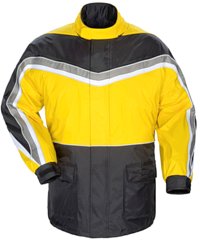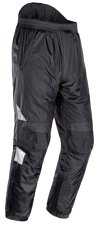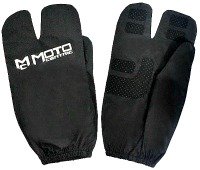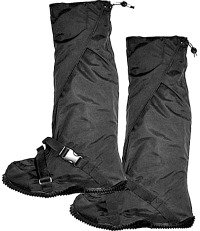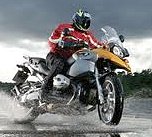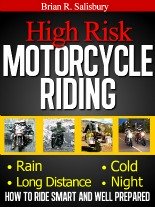Sign up today to get your FREE newsletter and BONUS info!
How You Can Stay Dry and Safe When Riding
Your Motorcycle in the Rain
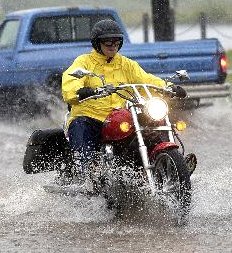
Riding your motorcycle in the rain is a common and potentially enjoyable part of the whole motorcycle riding experience.
Sure, we'd rather ride in dry, comfortable weather. But sometimes we can't avoid getting caught in the rain.
Whether you don't mind -- too much -- riding your motorcycle in the rain, or you only ride in wet weather when you must, here's info to help you to ride safe and stay dry when the road is full of puddles.
Your ability to stay safe and dry and to get the most satisfaction out of riding your motorcycle in the rain comes down to these two things…
Control and Clothes
You're safest when you ride in control…and you're most comfortable when you wear the right clothes to repel wet weather. Here's info to help you with both…
Ride smart, smooth and in control on wet roads
Riding smart and in control on wet roads starts with you being a smooth and extra cautious driver.
When you're on a motorcycle in the the rain…
- Allow lots of space to stop or slow down...
- Be gentle with the clutch, throttle, steering and brakes...
- Avoid sudden or jerky actions or reactions...
- Continually survey your surroundings...
- Be aware of the road and other drivers...
- Be sure other drivers have time to react to your moves
Here are some specifics…
Turning
- Initiate turns gradually...
- When entering a turn, downshifting early and engage the clutch smoothly...
- Avoid braking when leaning into turns...
- Gradually and steadily twist the throttle when exiting turns...
- Don't make sudden or extreme speed changes...
Braking
Give yourself plenty of extra space to slow down and/or stop safely when riding in the rain.
Stay within your comfort zone. No panic stops.
Again, smooth is the word when it comes to braking.
And engage the clutch slowly when downshifting.
Even though your front brakes provide nearly 90 percent of your braking power, apply gradual, even pressure at the same time front and back.
Keep your tires perpendicular to the road when braking.
Focus on not braking while leaning or turning.
Locking the front wheel when the tire is even slightly cocked could bring you down.
If your front tire is perpendicular to the road when it locks, you can ease off the brake and remain in control.
Occasionally operate the brakes with slight pressure to dry the brake surfaces.
Accelerating
Don't accelerate abruptly. Stay smooth. Gradually roll on the throttle.
Similar to braking, only accelerate when your wheels are exactly perpendicular to the road.
If your rear wheel loses traction while you're accelerating, roll back on the throttle to regain stability.
Standing water ahead
Look out for standing water in the road and avoid riding through it at any speed.
- A flooded road or standing water could…
- Make you loose control of your bike
- Short-circuit an electrical connection and cause a stall
- Hide deep potholes and dangerous debris
- Soak your brakes and make them temporarily ineffective
- Drench you completely
Click here for a great place to find wet weather riding gear...
Puddles in the road or on either side
Don't ride through puddles in the road or on either side when, for example, you pull over to put on your rain suit.
Puddles may hide deep potholes, rough surfaces or debris that can wreck your tires, bend your rims or cause you to lose control.
Changing lanes
When changing lanes, signal early, check your blind spot and give yourself plenty of room to make a move.
Then remain perpendicular to the road when proceeding smoothly left or right.
Avoid metal road surfaces
Go around or otherwise avoid riding across metal surfaces such as manhole covers, road construction plates, railroad tracks and bridge gratings.
If you must cross or ride across such surfaces, don't brake, lean or accelerate abruptly.
Don't go across railroad tracks, cattle grates and similar surfaces on an angle.
Cross them straight and perpendicular -- as if you're crossing a "T."
Don't put either foot down for support when riding on a metal surface, such as a grated bridge surface.
If you lose control, your extended leg won't hold you up or help you to regain your balance. And, most likely, you'll break your leg or foot.
Riding on ice
Don't ride on ice. If you must cross a large patch of ice, ride straight up. Don't lean.
Don't use your brakes on ice.
If you want to slow down, apply the clutch and coast in neutral until you stop or until you can roll onto a surface where you can apply your brakes.
Tar snakes
Avoid tar snakes -- those long, slippery tar-sealed cracks or patches in a road surface.
If tar snakes are all over the road, treat them like slick pieces of metal.
Don't lean into turns. Drive as straight up as possible. Apply your brakes smoothly when necessary.
Painted roadway lines
Treat painted roadway lines as if you're riding across tar snakes or a slick metal road surface.
If you must pass another vehicle, cross a slick center line smoothly and without leaning.
Go slowly when crossing an intersection that contains a painted pedestrian crosswalk.
Watch out for painted lines when turning left or right. Go slowly and smoothly. Don't lean.
Oil on the road
Oil can appear all over the road, but it is especially slick and dangerous when the rain is just starting.
Slow down and don't lean into turns.
Steer clear of rainbow-colored oil pools decorating the wet road surface.
Don't ride in the middle of the lane or stop in the center of a lane at an intersection.
Oil dripping from cars builds up most in the middle of lanes.
Stay close to the toll booth when going through or stopping in a toll lane. Oil gets really thick in the center of the lane.
You might be able to stop okay on this oil, but your foot can slip when you put it on the ground when paying the toll.
Try to plant your foot on the un-oiled curb in front of the toll booth.
Wet leaves
In the fall or during a windy rain storm, wet leaves may cover the road.
Slow down, watch out for laves in your path and focus on smooth cornering and careful braking.
Rocks
Don't ride on the edge of the road where rocks and gravel accumulate.
And stay alert for large rocks that rolled onto the road during heavy rains.
Water blasts
Don't ride too close the center-line or the median separating you from traffic traveling in the opposite direction.
Oncoming vehicles, especially big rigs, throw up huge blasts of water that can give you a physical jolt and impair your vision.
The right apparel and riding gear will keep you dry
The "secret" to staying dry and warm when riding your motorcycle in the rain is to wear apparel designed specifically to withstand the rigors of riding and to repel water when you're traveling at high speeds.
It's always best to stop in a safe place and casually put on your raingear before you're actually stuck in a downpour.
Searching your saddlebag for your raingear then trying to pull it on during a storm is tough enough.
But doing it on the side of the road with cars and trucks whizzing by is an extra layer of anxiety you don't need.
The most comfortable raingear has "breathability." It can keep the rain out while letting your body moisture pass through and away. Gore-Tex and similar synthetic fibers have this quality.
You can use your raingear as an extra layer to block the cold when riding in chilly or even frigid weather.
So it's a good idea to select durable, effective wet weather apparel you can rely on for such other purposes.
Here's what you should look for when choosing specific gear and apparel to keep you dry when riding you motorcycle in the rain...
Click here for a great place to find wet weather riding gear...
Motorcycle rain jacket
You can wear a …
- Regular motorcycle jacket lined with a rainproof material such as Gore-Tex
- Or you can pack a rain jacket made of Gore-Tex or a similar breathable, waterproof material to cover your motorcycle jacket
Features you want in a rain jacket include…
- A high collar you can seal securely to keep water from blowing inside
- Sleeve cuffs that seal securely to keep the water out
- An ample fit that lets you pull on the jacket easily over your motorcycle jacket
- Reflective material that makes you stand out in gray rainy weather and at night
- Straps and closures on the sleeves and around the waist to snug everything down, keep the water out and prevent loose fabric from flapping around
Motorcycle Rain Pants
Similar to your heavy duty jacket, you can wear…
- Motorcycle pants made to protect you in a crash that are also lined with a rainproof material such as Gore-Tex
- Or you can pack rain pants made of Gore-Tex or a similar breathable, waterproof material to cover your primary motorcycle pants
Features you want - or at least to consider -- in such rain pants include…
- Waterproof zippers on the waist and ankles to make them easy to slip on over bulky motorcycle pants and boots
- Good seals or closures around your ankles to keep the water out
- An elastic strap anchoring the bottom of each leg to the bottom of each boot to prevent them from riding up in the wind
- A high waste or bib front that extends over your torso to prevent rain from seeping under your jacket or through its zippers.
- Suspenders to keep your pants securely positioned
- Reflective material that makes you stand out in rainy weather and at night
Click here for a great place to find wet weather riding gear...
Waterproof Motorcycle Gloves
Similar to wet weather motorcycle jackets and pants, you can wear…
- Motorcycle gloves lined with a rainproof material such as Gore-Tex
- Or you can pack rainproof glove covers made of Gore-Tex or a similar breathable, waterproof material to pull over your every-day motorcycle gloves
Some of these glove covers are similar to three-fingered mittens.
The main advantage of wet-weather glove covers -- regardless of the style -- is they let you keep the comfort and protection of your regular riding gloves while doing a better job of repelling the rain.
They're compact and store easily.
Features you want in such glove covers include…
- Long gauntlets that extent high over your jacket cuffs to prevent water from running down and inside your gloves
- Good traction and a firm, comfortable, flexible fit that helps you to feel and operate your bike's controls and to easily use your fingers
Waterproof motorcycle boots
Similar to wet weather motorcycle jackets and pants, you can wear…
- Motorcycle boots lined with a rainproof material such as Gore-Tex
- Or you can pack rainproof boot covers made of rubber, nylon and even Gore-Tex or a similar breathable, waterproof material you can pull over your every-day cycle riding boots
The main advantage of wet-weather boot covers is that you can wear any kind of boot you like, and if it is not waterproof -- no problem. Just pull these on.
Boot covers are light-weight and easy to pack. And they do a nice job of keeping your feet dry.
Most are designed to slip over the front and upper portion of your boot while leaving the bottom of the sole exposed.
The disadvantage is that boot covers can be baggy and not very good for off-bike wear or walking around.
If you've never worn them before, they can take getting used to.
You might want to tighten down the upper portion and hold the boot cover in place by stretching an elastic Velcro strap around your calf.
Features you want in wet-weather boot covers include…
- Easy-on and easy-off
- Snug fit so they stay up
Helmets best suited for motorcycle riding in the rain
A full face helmet will give you the greatest amount of accident protection while also protecting you from rain, wind and cold.
If you'd rather ride with an open face helmet, you'd be most comfortable on your motorcycle n the rain if you snap on a helmet visor to keep you from getting pelted by rain drops.
If you don't use a visor, you'll need a good pair of goggles to protect your eyes. You'll also need and a bandana or some other type covering for your face.
You'll get the lease amount of protection from the weather and in an accident if you wear a half helmet.
And -- with a half-helmet -- you'll really need a good pair of goggles to protect your eyes when it rains and a bandana across your face to reduce the impact of hard-driving rain drops.
Riding your motorcycle in the rain can be a very enjoyable experience.
When you know how to stay dry, warm and in control, you can enjoy the fresh clear air and the uniqueness of cruising in the rain when others are huddling inside.
In my continuing efforts to provide you with the best information possible, I've teamed with a great resource where you can find a wide variety of apparel for riding your motorcycle in the rain…
I encourage you to click here for a great place to find wet weather riding gear just right for you…
Plus you get free shipping…
Want to be better prepared to deal with high-risk motorcycle riding situations?
Increase your motorcycle driving skills and confidence when…
· Riding at night…
· Riding in the rain…
· Riding in cold weather…
· Riding across long distances…
You'll find a wealth of effective motorcycle driving and control tips and techniques for challenging situations -- and more -- in my book "High Risk Motorcycle Riding."
Click here for more information about what you'll find in this revealing book and where to zero-in on a copy for yourself…
Return from Riding in the Rain and go back to
Let's stay in touch!
Get your free subscription to..."Savvy Motorcyclist E-zine"
And you'll also receive your free copies of...“The 10 Best Motorcycle Travel and Trip Planning Websites on the Internet” ... plus the Motorcycle Safety Foundation’s 58-page Motorcycle Operator’s Manual.
These great resources will help you to ride better, plan your trips, enjoy the best motorcycle roads and get the most out of motorcycle riding.

